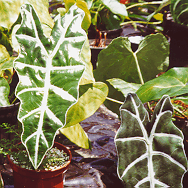Alocasia
This group consists of seventy, tender plants, which grow from rhizomes in the tropical forests of Borneo, Ceylon, Malaysia and Asia. These plants (commonly known as African Masks and Elephant's Ears) are mainly valued for their gorgeous leaves, which are very large, heart- or spade-shaped and beautifully colored and variegated in gleaming shades of green, purple, bluish-green, red and bronze. They also produce small, calla-like flower spathes. A. cuprea produces erect clumps of foliage up to 3 feet in height. Long stalks are topped with 12-inch-long, heart-shaped, puckered leaves. They are a lustrous purplish-green above and purple beneath. This variety sporadically produces its purple spathes. A. macrorbiza produces large, spade-shaped leaves and edible, tuberous roots, which provide an important food item throughout tropical Asia. The glossy, green leaves of this species grow from thick stems, which may remain below ground or stretch out a few feet as a ringed trunk. Small forms of this variety may grow only a foot or two, while large strains may reach four to five feet before they begin to form a trunk, eventually reaching a height of up to ten feet. Elephant's Ears are excellent when grown as houseplants and can be grown outdoors in mild, tropical climates.
POTTING
Elephant's Ears need a minimum temperature of 60º F. These plants prefer partial shade and high humidity. Grow them in a very well-drained location in a mixture of ground bark, soil, sharp sand, and charcoal. When growing in containers, set them so that the top of their rhizome isn't below the rim of the pot or else the bottom leaves could decay at the base. Water freely while in active growth, but in the fall, decrease their water as the leaves begin to fade. Once they have died for the winter, water only once in a while. Some varieties of Elephant's Ears can even be grown in or near ponds.
PROPAGATION
In early spring, the rhizome can be divided into pieces and planted in small pots of peat and sand, which are then placed in a propagating case in the greenhouse. Stem cuttings may be rooted. Seeds can also be used.
VARIETIES
- A. amazonica
- A. argyraea
- A. cucullata
- A. cultivars
- A. cuprea (dark metallic purple-green leaves, & purple beneath);
- A. indica varieties metallica (purple leaves w/ a metallic sheen) & variegata (deep green & gray underneath);
- A. korthalsii
- A. longiloba (arrow shaped leaves, white veins & perimeters);
- A. lowii (olive green, deep purple underneath) & variety Veitchii (has white veins);
- A. macrorrhiza (green w/ wavy edges) & its variety variegata (has white blotches on its leaves);
- A. micholitziana
- A. mortefontanensis
- A. odora
- A. plumbea
- A. portei
- A. putzeysii
- A. Sanderiana (arrow-shaped leaves, lobed margins & white veins & margins);
- A. scabriuscula
- A. sedenii
- A. veitchii
- A. watsoniana (puckered blue-green leaves w/ white veins);
- A. zebrina (has zigzag bands on the leafstalks).





